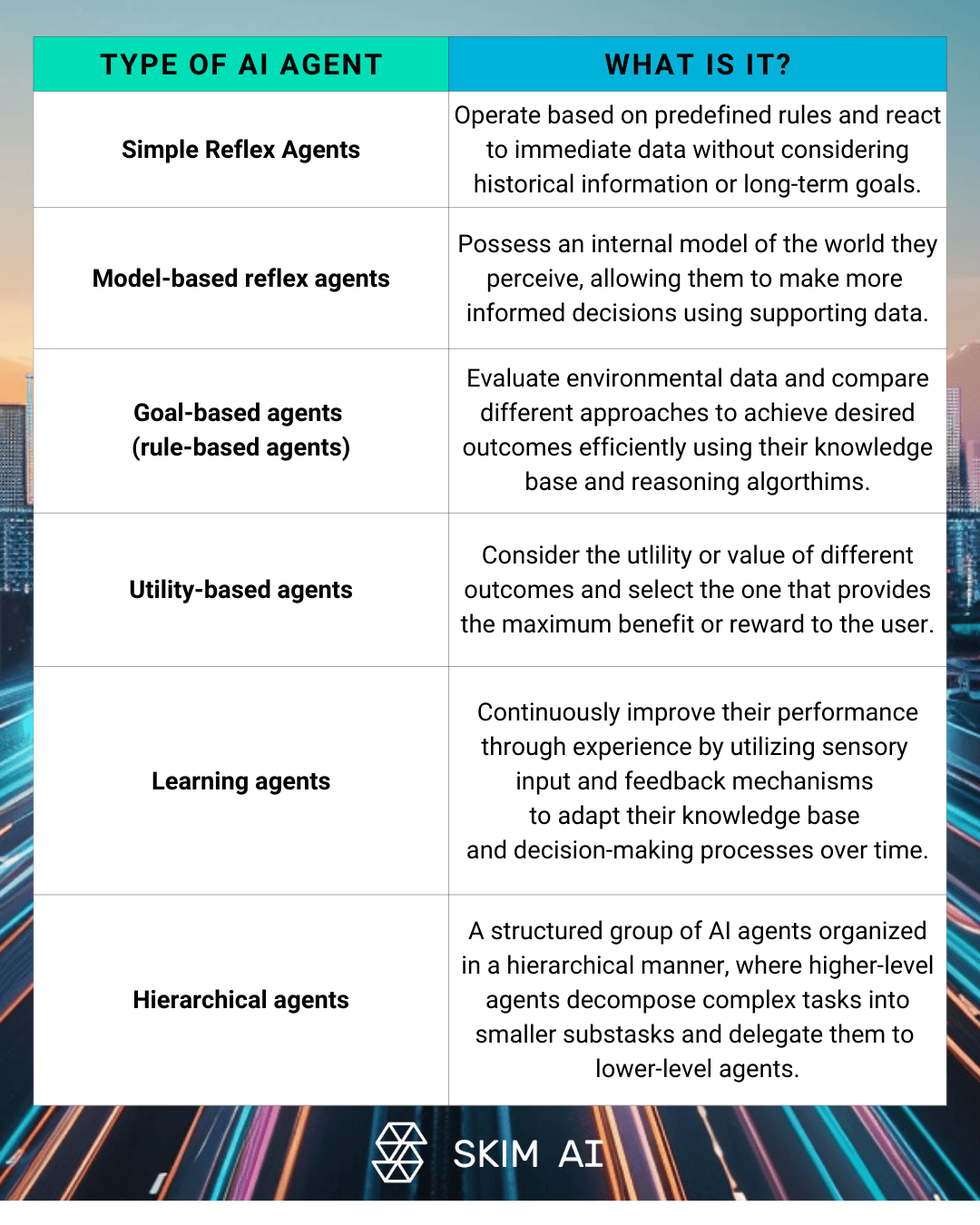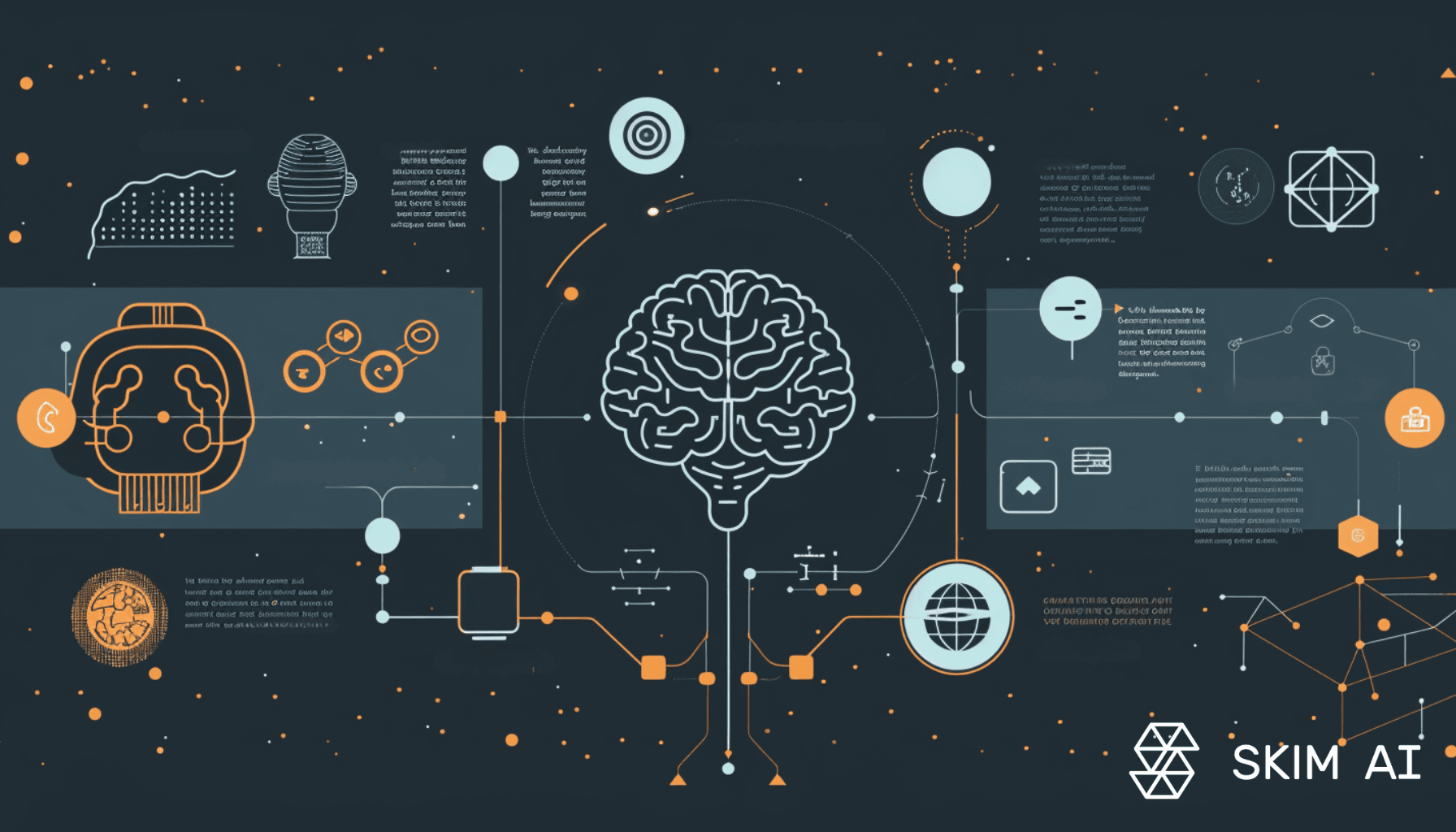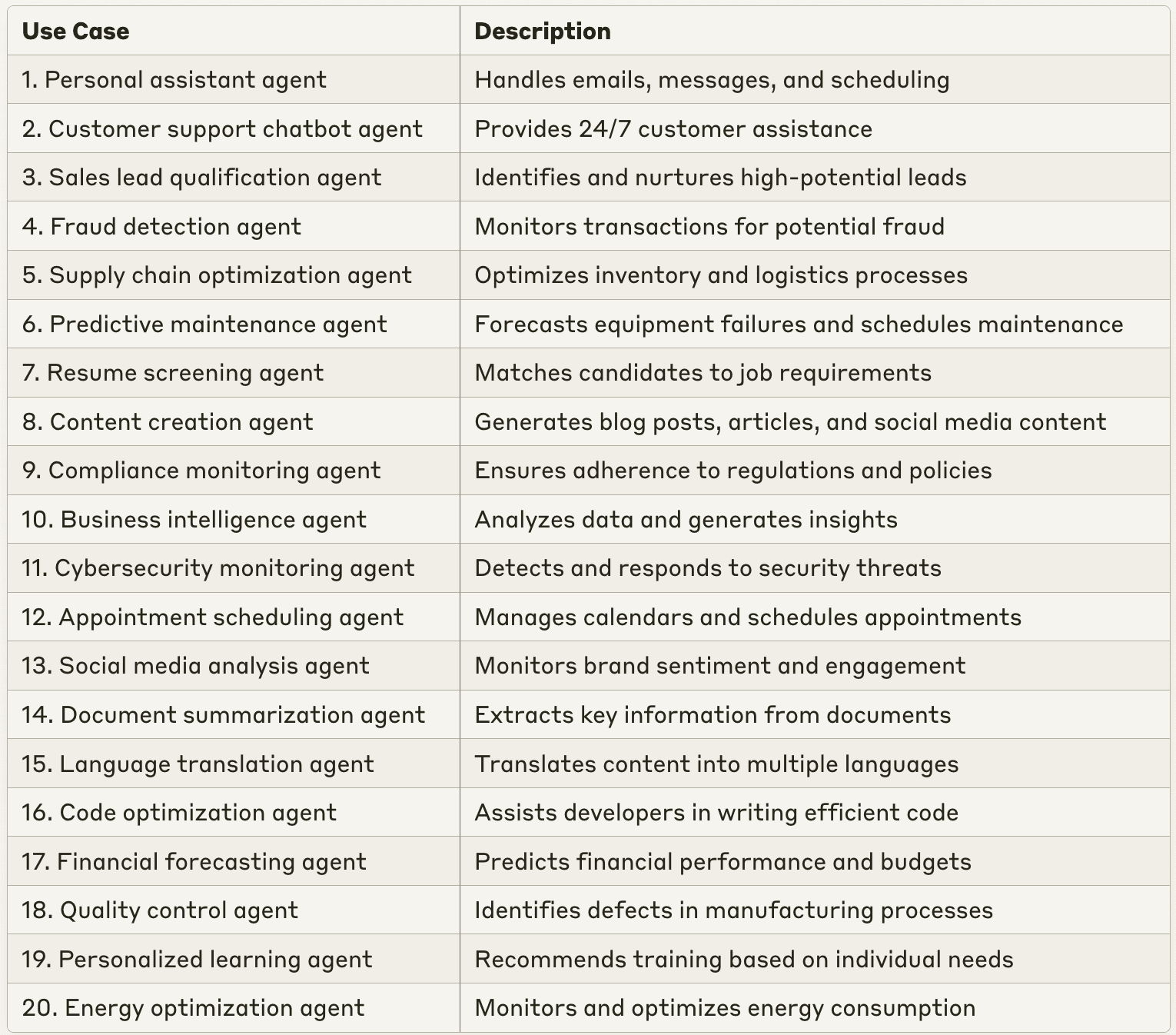Enterprise Guide to AI Agents + Agentic Workflows + Architectures
In the field of AI, agents are gaining significant traction in enterprise settings due to their ability to perform complex tasks autonomously, reducing the need for human intervention. These intelligent agents leverage advanced technologies like natural language processing (NLP) and machine learning to interact with users, process data, and make informed decisions. As enterprises seek to harness the power of AI, understanding the various types of AI agents and their capabilities is essential.
AI agents are the most disruptive development we’ve had to date in the field. They are the next big step in AI evolution and hold the potential to impact every industry and task drastically.
This guide provides a comprehensive look into AI agents and their architectures, enabling your organization to make informed decisions when implementing these technologies.
Types of AI Agents
As your enterprise explores the potential of AI agents, it is crucial to understand the various types of agents available and their unique capabilities. Each type of AI agent is designed to address specific challenges and cater to different use cases within your organization. From simple reflex agents that respond to immediate stimuli to more advanced learning agents that continuously improve their performance, the spectrum of AI agents offers a wide range of possibilities for enterprises like yours looking to automate tasks, streamline processes, and enhance decision-making.

Simple reflex agents
Simple reflex agents are the most basic type of AI agent. They operate based on predefined rules and react to immediate data without considering historical information or long-term goals. These agents are suitable for straightforward tasks that do not require extensive training or complex decision-making. In enterprise settings, simple reflex agents can be employed for tasks such as automated email responses, chatbots for basic customer support, or monitoring systems for specific triggers.
Model-based reflex agents
Model-based reflex agents are an advancement over simple reflex agents. They possess an internal model of the world they perceive, allowing them to make more informed decisions. These agents use supporting data to build and update their models, enabling them to consider probable outcomes and consequences before taking action. While model-based reflex agents are more sophisticated than simple reflex agents, they still rely on predefined rules and models. Enterprises can utilize model-based reflex agents for tasks such as inventory management, predictive maintenance, or fraud detection.
Goal-based agents
Goal-based agents, also known as rule-based agents, are AI agents with advanced reasoning capabilities. These intelligent agents not only evaluate environmental data but also compare different approaches to achieve desired outcomes efficiently. Goal-based agents use their knowledge base and reasoning algorithms to determine the most effective path to reach their goals. They are well-suited for complex tasks that require planning and decision-making, such as natural language processing (NLP), robotics, and autonomous systems. In enterprise contexts, goal-based agents can be applied to automate business processes, optimize resource allocation, or personalize user experiences.
Utility-based agents
Utility-based agents take goal-based agents a step further by considering the utility or value of different outcomes. These AI agents use complex reasoning algorithms to evaluate various scenarios and select the one that provides the maximum benefit or reward to the user. Utility-based agents are particularly useful in situations where there are multiple competing objectives or when the best decision depends on user preferences. For example, a utility-based agent can assist customers in finding the most suitable product or service based on their specific requirements, such as price, quality, or delivery time.
Learning agents
Learning agents are AI agents that continuously improve their performance through experience. These agents utilize sensory input and feedback mechanisms to adapt their knowledge base and decision-making processes over time. Learning agents can be trained using various machine learning techniques, such as supervised learning, unsupervised learning, or reinforcement learning. By constantly updating their models based on new data and past results, learning agents can refine their abilities and tackle increasingly complex tasks. In enterprise settings, learning agents can be employed for applications like predictive analytics, dynamic pricing, or personalized recommendations.
Hierarchical agents
Hierarchical agents are a structured group of AI agents organized in a hierarchical manner. In this architecture, higher-level agents decompose complex tasks into smaller subtasks and delegate them to lower-level agents. Each agent operates autonomously, focusing on its assigned subtask, and reports progress back to its supervising agent. The higher-level agents coordinate the efforts of their subordinates, ensuring that the overall goal is achieved efficiently. Hierarchical agents are particularly useful for managing large-scale, multi-faceted projects in enterprises, such as supply chain optimization, workforce management, or complex decision support systems.
Here at Skim AI, we believe the greatest potential is held in hierarchical and custom-built agents.
Key Components of AI Agent Architectures
To effectively implement AI agents within your enterprise, it is essential to understand the key components that make up their architectures. These components work together to enable AI agents to perceive, reason, learn, and interact with their environment, ultimately driving value for your organization.
By familiarizing yourself with these building blocks, you can make informed decisions when designing and deploying AI agents that align with your enterprise’s specific needs and goals. In this section, we will explore five critical components of AI agent architectures: perception and data inputs, knowledge representation, reasoning and decision-making, learning and adaptation, and communication and interaction.

1. Perception and data inputs
Perception and data inputs are crucial components that allow AI agents to gather information from various sources within your enterprise’s digital ecosystem. This data serves as the input for the agent’s decision-making process. In your organization, AI agents can be integrated with various data sources, such as databases, APIs, log files, or other software-based data feeds, to collect relevant information.
Data preprocessing techniques may be applied to clean, transform, and normalize the data, ensuring that it is suitable for the agent’s consumption. By equipping your AI agents with robust data integration capabilities, you enable them to have a comprehensive understanding of the context in which they operate, leading to more accurate and informed decisions.
2. Knowledge representation
Knowledge representation is a fundamental aspect of AI agent architectures that enables your enterprise to encode domain-specific information in a structured and machine-readable format. This component involves creating ontologies and knowledge bases that capture the concepts, relationships, and rules relevant to your organization’s domain.
By representing knowledge in a formal manner, AI agents can reason more effectively and make decisions that align with your enterprise’s goals and constraints. Depending on the specific requirements of your use case, you may employ various knowledge representation techniques, such as semantic networks, rule-based systems, or probabilistic models.
3. Reasoning and decision-making
Reasoning and decision-making are the core capabilities that empower AI agents to process information, draw conclusions, and take actions that drive value for your enterprise. This component leverages the knowledge representation and perception data to generate insights and recommendations.
AI agents can employ various reasoning techniques, such as rule-based reasoning, where the agent follows predefined rules to make decisions, or probabilistic reasoning, where the agent considers uncertainty and multiple possible outcomes. In your enterprise context, AI agents can support decision-making processes by analyzing complex data, identifying patterns, and providing data-driven recommendations to human decision-makers.
4. Learning and adaptation (Self-Improving Agents)
Learning and adaptation are essential components that allow AI agents to continuously improve their performance and adapt to changing conditions within your enterprise. By incorporating machine learning techniques, such as supervised learning, unsupervised learning, or reinforcement learning, AI agents can learn from historical data, user feedback, and real-time interactions.
This enables them to refine their knowledge base, optimize their decision-making processes, and personalize their responses to better serve your organization’s needs. As your enterprise evolves and new data becomes available, AI agents with learning capabilities can automatically update their models, ensuring that they remain relevant and effective over time.
5. Communication and interaction
Communication and interaction are vital components that enable AI agents to effectively engage with human users and other systems within your enterprise. NLP techniques allow AI agents to understand and generate human-like responses, facilitating seamless communication between agents and employees, customers, or partners.
By leveraging NLP, AI agents can interpret user queries, provide informative responses, and even engage in multi-turn conversations. In addition to human-agent interaction, AI agents can also communicate with other agents or systems within your enterprise, exchanging data and coordinating actions to achieve common goals. This enables the creation of collaborative agent ecosystems that can tackle complex problems and streamline processes across your organization.
How to Design and Implement AI Agents in Your Enterprise
Now that we have explored the various types of AI agents and the key components of their architectures, it’s time to delve into the process of designing and implementing AI agents within your enterprise. This section will guide you through the steps necessary to successfully integrate intelligent agents into your organization’s workflow, from identifying suitable use cases to deploying and maintaining your AI agents. By following these best practices, you can ensure that your enterprise leverages the full potential of AI agents, driving efficiency, productivity, and innovation across your operations.
Step 1: Identify Use Cases
The first step in implementing AI agents within your enterprise is to identify the most appropriate use cases. Consider areas where intelligent agents can have the greatest impact, such as process automation, decision support, or customer service. Evaluate your organization’s pain points, repetitive tasks, and data-intensive processes to determine where AI agents can provide the most value. Engage with stakeholders from different departments to gather insights and requirements, ensuring that the selected use cases align with your enterprise’s overall goals and strategy. No task is role is off limits. If you are the CEO or a leading voice in the company, create a custom personal assistant AI agent.
Here are some of our recommended use cases for AI agents:

Step 2: Select the appropriate agent types and architectures
Once you have identified potential use cases, the next step is to select the most suitable AI agent types and architectures for each scenario. Consider factors such as the complexity of the tasks, the level of autonomy required, and the available data resources. For example, simple reflex agents may suffice for straightforward tasks, while goal-based agents or learning agents may be more appropriate for complex, dynamic environments. Additionally, evaluate the scalability and performance requirements of each use case to ensure that the chosen agent architecture can handle the expected workload and integrate seamlessly with your enterprise’s existing systems.
Step 3: Prepare to connect your enterprise data
Data is the fuel that powers AI agents, and ensuring that your organization has high-quality, relevant data is crucial for their success. Before implementing AI agents, invest time in collecting, cleaning, and preprocessing the necessary data. This may involve integrating data from various sources, such as:
Company website content
Social media posts
Customer feedback and reviews
Leadership communications and thought leadership materials
Marketing materials and campaigns
Internal communication
Sales and customer support scripts
Product descriptions and user manuals
Video and audio content transcripts
User guides and FAQs
Establish data governance policies and procedures to maintain data quality, security, and privacy throughout the lifecycle of your AI agents.
Step 4: Train and test your AI agent
With the appropriate data in place, the next step is to train and test your AI agents. Provide your agents with representative training data and define clear performance metrics to evaluate their effectiveness. Conduct thorough testing and validation to ensure that your AI agents can handle edge cases, adapt to changing conditions, and make accurate decisions. Continuously monitor and refine your agents’ performance based on real-world feedback and evolving business requirements.
Step 4: Deploy and maintain
Once your AI agents have been trained and tested, it’s time to deploy them within your enterprise’s infrastructure. Ensure that your agents are seamlessly integrated with existing systems, such as databases, applications, and user interfaces. Establish clear communication channels between your AI agents and human users, leveraging NLP techniques to facilitate intuitive interactions.
Implement robust security measures to protect sensitive data and prevent unauthorized access to your AI agents. Regularly monitor your agents’ performance, conduct maintenance tasks, and apply updates as necessary to keep them running smoothly and aligned with your enterprise’s evolving needs.
Don’t Overlook AI Agents in Your Enterprise
AI agents are emerging as the most transformative force in the modern business landscape, offering enterprises unparalleled opportunities to streamline processes, enhance decision-making, and drive innovation. By understanding the various types of AI agents, their key architectural components, and best practices for implementation, your organization can harness the power of these intelligent entities to gain a competitive edge.
As you begin your AI agent research and implementations, remember that success lies in careful planning, strategic use case selection, and seamless integration with your existing systems and data. By leveraging the right mix of agent types, architectures, and training data, you can create a powerful ecosystem of intelligent assistants that work collaboratively to achieve your business objectives.
Don’t let your organization fall behind in the race to adopt AI agents. Contact Skim AI today to learn how our expertise can help you seamlessly integrate AI agents and agentic workflows into your enterprise, unlocking new levels of efficiency, insights, growth, and ROI.
FAQ
What are AI agents?
AI agents are autonomous software entities that can perceive their environment, reason, learn, and interact with users or other systems to achieve specific goals or tasks within an enterprise setting.
What is an agentic workflow?
An agentic workflow is a collaborative process where multiple AI agents work together autonomously, making decisions and taking actions based on their own goals and understanding of the environment, to achieve a common objective efficiently.
What are the types of AI agents?
The main types of AI agents include simple reflex agents, model-based reflex agents, goal-based agents, utility-based agents, learning agents, and hierarchical agents, each with varying levels of complexity and decision-making capabilities.
How can my enterprise use AI agents?
Enterprises can utilize AI agents for various purposes, such as automating repetitive tasks, assisting in decision-making processes, enhancing customer support, optimizing resource allocation, and improving overall operational efficiency.
How do AI agents differ from traditional chatbots?
AI agents are more advanced and autonomous than traditional chatbots, with the ability to learn, adapt, and make decisions based on their environment and goals, while chatbots are typically rule-based and limited to predefined responses.






